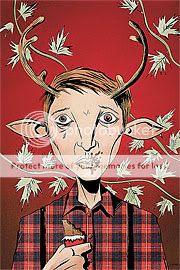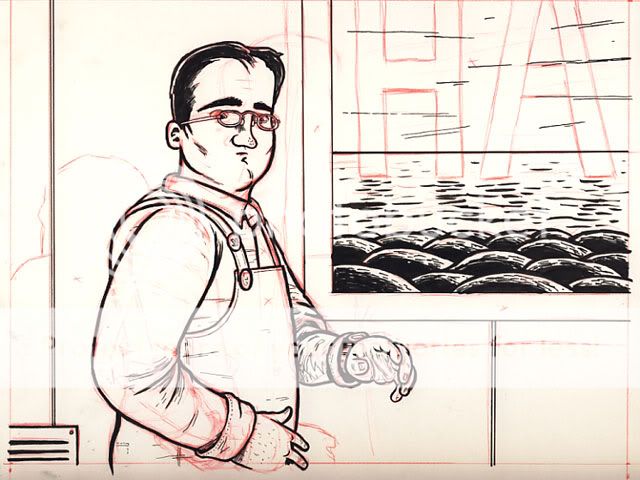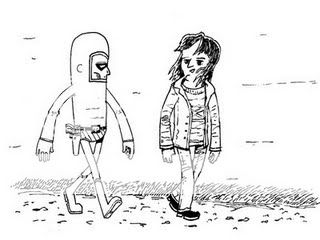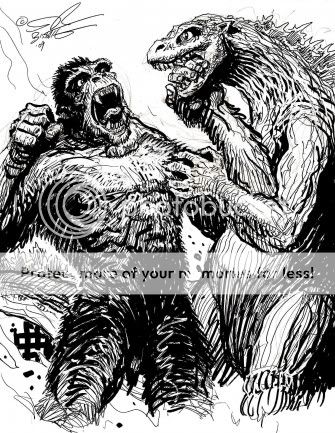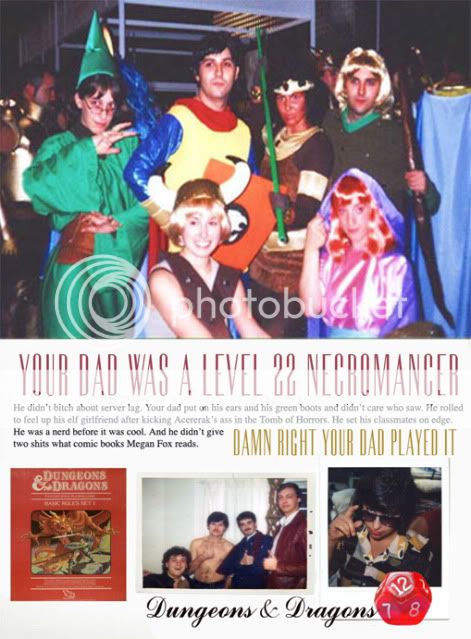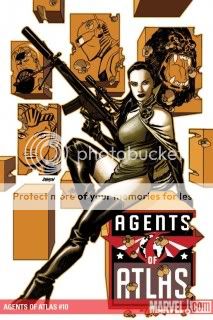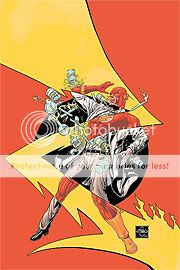You may recall that a while back I took a break from reviewing comics thrice weekly. I’d done it for a year and a quarter or something like that and felt I’d accomplished what I set out to accomplish. I was also getting a little sick of feeling obligated to read and review comics–the second something becomes homework I want nothing to do with it–and was looking forward to reading some prose for a change. Because I am a strange and in some ways fundamentally unpleasant person, the prose book I chose to read during my break from comics was Ian Kershaw’s 1,072-page Hitler: A Biography. I learned a lot from that book. One of the things I learned was that after the war took a turn for the worse, for Germany that is, Hitler pretty much stopped making any kind of public appearances, even radio addresses. During the darkest years of the war, his public addresses literally numbered in the single digits. Try to imagine the President disappearing from public view 362 days out of the year, as enemy forces bomb the hell out of you while your sons and husbands freeze to death in Russia, and you can imagine what this would do to morale in America, let alone a country that had been trained to worship Adolf Hitler as the personification of the nation. But no amount of cajoling, even from his fanatically loyal propaganda minister Joseph Goebbels, could persuade Hitler to re-enter the spotlight while his “plans”–sneer quotes richly deserved, since they basically amounted to “if we want to win really, really bad, we’ll win”–were busy being shown to be the ridiculous delusions of grandeur that they were. He didn’t want to lose face, but perhaps even more revealingly, he simply didn’t give a shit about the suffering of the German people. After all, if they were losing, it stood to reason that they didn’t want to win badly enough, and therefore didn’t deserve his recognition and consolation anyway.
This leads to the second major thing I learned reading that book, about appeasement. During the years I spent vociferously supporting the war efforts of an administration whose vice-president is now voluntarily appearing on television to publicly proclaim how very, very proud he is of an interrogation system that involved holding power drills to people’s heads, threatening to rape their mothers, and of course killing them, appeasement was the ugliest word around. One of my proudest moments, and by proudest I mean most retrospectively nauseating, in a literally physical sense, involved thinking of post-3/11 Spain as a nation of Neville Chamberlains. (I don’t remember if I actually wrote this–Jim Henley might, but I don’t–and I don’t have the stomach to dig through the archives to find out; I ask you to take my word for it.) But what I learned is that the actions of Chamberlain and the other European governments prior to the war had nothing to do with being giant pussies who didn’t have the balls to go kill them some Nazis and defend human freedom against Cobra, a ruthless terrorist organization determined to rule the world. What it had to do with was remembering how around 20 years earlier, the nations of Europe had collectively fed themselves into a nightmarish meat grinder, and could we please try to avoid slaughtering tens of millions of our children in the near future. After reading Kershaw’s book, I don’t get the sense that Chamberlain’s appeasement at Munich had anything to do with a moral defect on the part of Chamberlain or anyone else, anyone else but Hitler that is. They might have done better to heed the warning signs, but they felt they were acting out of an abundance of caution, caution about plunging Europe into yet another ruinous Great War. Their great miscalculation was believing Hitler felt the same way. Unfortunately, as Kershaw documents at great length, Hitler literally couldn’t have cared less about human suffering. The potential death of millions of people of any race, even Germans, was vanishingly low on his list of concerns. Chamberlain’s screw-up was playing chicken with a sociopath, just as Germany’s screw-up (among many!) was casting its lot with one–through ignorance, through chauvinism, through bloodthirstiness, through complacency, through conformity, through fear, through compulsion, through a little of it all. The same inhuman lack of empathy that led him to attack Poland and France and the U.S.S.R. was the same inhuman lack of empathy that caused him to abandon the people on whose nominal behalf he ordered those invasions.
The third thing I learned from that book was that he had nine lives like a cat. Hitler survived something like eight assassination attempts. Not plots–attempts, as in bombs with fuses lit. But schedules were changed, explosives failed to detonate, table legs blocked blasts, and history’s greatest monster lived to sit in his compounds and bore his captive audiences with rants about Wagner and American cinema and the character of International Jewry and the prowess of Stalin another day.
The fourth thing I learned from that book was that Hitler loved the movies.
Inglourious Basterds, Quentin Tarantino’s, I dunno, sixth or seventh film, posits a world in which movie violence fights against real-world violence, specifically the violence of Hitler’s Nazi regime. The film’s first act of violence involves the machine-gun slaughter of a Jewish family; the second involves a guy from The Office scalping German soldiers, a crazy anti-Nazi German serial killer reaching his hand down an SS officer’s throat, and the director of Hostel beating a Nazis to death with a baseball bat onscreen. The first outburst is led up to with nearly unbearable tension, in one of the lengthy, dialogue- and closeup-driven short-films-within-a-film that have become Tarantino’s trademark. We have a feeling we know where it’s going, as do the characters involved, and it makes us sick and revolted. The second outburst, naturally, is therefore greeted with cheers and laughter. This isn’t despite it being much more graphically violent than the initial massacre–it’s because it’s much more graphically violent.
This second outburst of violence is movie violence, the violence of Tarantino’s much-ballyhooed “movie movie” world, operating at a layer of unreality above a normal movie. This movie violence is pitted against the backdrop of unspeakable and very real barbarism unleashed by Hitler’s regime, and we root for it to prevail. And it’s not like Tarantino’s being subtle about this, either. He cast the biggest movie star he’s worked with yet in the lead. He cast a fellow director in a key supporting role. He cast (spoiler alert!) Mike “Austin Powers” Myers as a veddy veddy British intelligence officer, and formerly glorious specimen of manhood Rod “The Birds” Taylor as Winston Churchill, and the instantly recognizable voices of Tarantino repertory company members Samuel L. Jackson and Harvey Keitel in notable voiceover parts. Within the story itself, one of the main characters is a German movie star turned spy, and another is a German soldier turned movie star, and yet another is the German propaganda minister turned director and studio head. There’s a key conversation about King Kong, famously one of Hitler’s favorite films. The whole movie centers on a plot called “Operation Kino” that climaxes in a movie theater during the premiere of an ultraviolent German propaganda film based on “real” events. Actual film is used as a weapon for god’s sake. But it didn’t take me any longer to suss out this theme than Brad Pitt’s utterance of the line, “Quite frankly, watching Donnie beat Nazis to death is the closest we get to going to the movies.” Even the characters realize they’re perpetrating movie violence. And as those who have seen the whole movie can no doubt attest, to say that this is the “movie movie”est movie in Tarantino’s oeuvre is to understate the case considerably. Considerably. I mean, the very idea of the movie calls attention to its own movieness. You know how a movie about a plot to kill Hitler has to end, right?
In that sense Inglourious Basterds may be the punkest movie I’ve seen in I can’t even think how long. Maybe ever. It’s about nothing less than the power of art to destroy evil. It’s about how important it is to love film more than the likes of Hitler hate life. It’s about how movie violence, art violence, art designed as a FUCK YOU, can help you deal with the violence that so terrified Chamberlain’s cohorts and to which Hitler and his cohorts were so indifferent. It’s Woody Guthrie’s “THIS MACHINE KILLS FASCISTS” guitar slogan made literal. It’s a lingering closeup on the bloodlust-saturated eyes of Eli Roth, the beautiful Jewish torture-porn poster boy and enemy of good taste, as he empties a machine gun into the bodies of members of the Third Reich. And it’s a total fucking fantasy. Yet that’s what makes it so vital. I mean, I’m pretty sure Johnny Rotten wasn’t actually the Anti-Christ, but in the end, did it matter? Well, I suppose it did. Punk toppled nothing. But it gave people the power to topple themselves. It gave them a psychic survival mechanism. I guess you could see that as the ultimate con-job of art. I think it’s noble. Glourious, even.
Last Wednesday I attended Nine Inch Nails’ supposedly final New York City performance ever at Terminal 5. This took place 15 years and three months after my first Nine Inch Nails concert–my first concert by anyone–at Roseland in May of 1994. I attended both with my best friend and AllTooFlat.com major domo Kennyb. I’m not a big concertgoer anymore, I tend to prefer spending $12 or whatever on an album and listening to it in the comfort of my headphones than plunking down $30 or $75 dollars and standing around in some sweaty venue in NYC, then taking the long Long Island Rail Road ride home and getting like six hours of sleep, but no way was I missing NIN’s final New York concert. They were my favorite band, identified as such for more than half a decade, and I still love Trent Reznor.
This turned out to be an excellent decision, one of the best I’ve made in a long time. The evening proved to be enormously cathartic. I screamed along to every word, pouring a year’s worth of awfulness out of my mouth and into the sweat that passed for air. “Broken, bruised, forgotten, sore, too fucked up to care anymore.” “Still stings these shattered nerves–pigs, we get what pigs deserve.” “Hey God, I think you owe me a great big apology.” “I’m gonna burn this whole world down.” But also: “I want so much to believe.” “I am trying to see, I am trying to believe.” “What if this whole crusade’s a charade?” And ultimately: “I’d rather die than give you control.” What was I singing about? The disease that is probably going to kill my poor cat? The addictions and mental illnesses that leveled my family? Whatever-it-was that killed two babies in my wife’s womb? The vote I cast for George W. fucking Bush? The town hall screamers? A non-existent God? My ex-love interests? The popular kids I hated for years? My wife? Myself? Human nature? Life? My solipsistic self-regard for thinking any of this matters to anyone else? All these things. As Ryan Dombal said in his review of the band’s show at Webster Hall a couple days earlier:
Reznor turned the tiny crowd’s unrequited dread into bliss yet again. Just like he did back in high school, or junior high, or even during a irrationally black college-and-beyond bender. Nine Inch Nails may be going dark, but confusion, anger, and despondency will abide.
When I was in high school, Nine Inch Nails was the king cool band among my circle. This is pretty far from the case at this point. But I’m still confused and angry and despondent a lot of the time–a lot more deeply so than I was in high school, in all probability. Screaming these lyrics back at Trent Reznor, which honestly is what they were tailor-made to do, I realized all that, and realized how wonderful it felt to vomit all that back out into the world again. As Trent sang “Bow down before the one you serve, you’re going to get what you deserve,” I raised my hands in the air, palms open and facing the stage, and suddenly noticed that half the audience had spontaneously done the exact same thing. We were somehow screaming out our fury at conformity, and acknowledging how all of us owed this band the exact same debt for enabling us to do so. I could feel myself getting better, somehow. It was magical.
A while back, I noticed during one of my rare schleps through my rudimentary referrer logs that a blogger who I think used to enjoy my writing called me a twat. (I’m not gonna say who it was or link to the diss. I don’t want this to become some kind of lame pissing match. I only bring it up because I’m a big crybaby, not to kick off some kind of blog battle. Those days are long gone. Besides, I’ve been a giant asshole to people on this blog many times, so it seems churlish to reprimand someone else for turning the tables.) He wouldn’t say why he felt that way, but as evidence for my twatitude, he cited this mix I made of my favorite Nine Inch Nails songs, which he characterized as slow-songs-only desperate plea for validation. Leave aside for a moment the fact that this mix included “Wish” and “Gave Up” and “Burn” and “The Becoming” and “Happiness in Slavery” and “Just Like You Imagined” and “10 Miles High,” some of the metalest fucking songs in the entire NIN catalog. Leave aside the fact that at the end of the post I promised a completely different mix of songs that I posted a week later, featuring nothing but NIN’s booty-shakin’ dancefloor bangers. You can even leave aside the fact that it’s tough to think of an artist whose work could get you less validation from the critical populace than freaking Nine Inch Nails. The music itself, the emotions it calls to mind, that’s all the validation I need. It really doesn’t matter what anyone else thinks, or what effect it does or doesn’t have on anyone else, or whether it ever gets me anywhere better than where I am now except for the moment. The art is enough because it’s saying something that’s in me. It’s giving me control for as long as it takes me to sing that chorus. No matter what happened in the real world, there’s value to Eli Roth shooting up a room full of Nazis.


